Parameters Determination via Fuzzy Inference Systems for the Logistic Populations Growth Model
Abstract
1. Introduction
2. Preliminaries
2.1. Necessary Knowledge About Fuzzy Inference Systems
- I is the set of linguistic variables of the inputs;
- R set of rules that relate the inputs to outputs;
- O set of linguistic variables of the outputs;
- f is a defuzzification method.
2.2. Foundations on Fuzzy Differential Equations
- (i)
- μ is normal; i.e., there exists al least one such that ;
- (ii)
- is closed ; and
- (iii)
- is bounded.
- (i)
- Addition:
- (ii)
- Subtraction:
- (iii)
- Reciprocal:if then ;if then is undefined.
- (iv)
- Multiplication:,where:,.
- (v)
- Division:.
- (vi)
- Multiplication by a scalar:
- (I)
- There exists an element such that for all sufficiently close to zero, there exist , and limitsare equal to , or
- (II)
- There exists an element such that for all sufficiently close to zero, there exist , and limitsare equal to .
- (i)
- If F is differentiable from Form-I, then and are differentiable functions andor
- (ii)
- If F is differentiable from Form-II then y are differentiable functions andwhere L and R are subindexes that represent the left and right extremes in interval algebra, respectively. The superindex α represents the function expressed in the α-cut.
2.3. Verhulst Logistic Model Expressed as Fuzzy Differential Equation
3. Determination of Fuzzy Coefficients
4. Experimental Results
4.1. FIS That Estimates Vulnerabilities of Marine Fishes
4.2. Proposal of Coefficients and
4.3. Solutions for the Fuzzy Verhulst Logistic Model
5. Discussion
6. Conclusions
Author Contributions
Funding
Data Availability Statement
Conflicts of Interest
Abbreviations
| Lw | Low |
| M | Medium |
| H | High |
| VH | Very High |
| NLw | Not Low |
| VR | Very Restricted |
| R | Restricted |
| NR | Not Restricted |
| S | Small |
| VL | Very Large |
| VLw | Very Low |
References
- Banerjee, S. Mathematical Modeling: Models, Analysis and Applications; Chapman and Hall/CRC: Boca Raton, FL, USA, 2021. [Google Scholar]
- Kalman, D. Verhulst Discrete Logistic Growth. Math. Mag. 2023, 96, 244–258. [Google Scholar] [CrossRef]
- Morales-Erosa, A.; Reyes-Reyes, J.; Astorga-Zaragoza, C.M.; Osorio-Gordillo, G.L.; García-Beltrán, C.D.; Madrigal-Espinosa, G. Growth modeling approach with the Verhulst coexistence dynamic properties for regulation purposes. Theory Biosci. 2023, 142, 221–234. [Google Scholar] [CrossRef] [PubMed]
- İskender, C. Mathematical Study of the Verhulst and Gompertz Growth Functions and Their Contemporary Applications. EKOIST J. Econom. Stat. 2021, 34, 73–102. [Google Scholar] [CrossRef]
- Adeyeye, O.; Omar, Z. Investigating accuracy of multistep block methods based on step-length values for solving Malthus and Verhulst growth models. In AIP Conference Proceedings; AIP Publishing: Melville, NY, USA, 2022; Volume 2472. [Google Scholar]
- Naso, P.; Lanz, B.; Swanson, T. The return of Malthus? Resource constraints in an era of declining population growth. Eur. Econ. Rev. 2020, 128, 103499. [Google Scholar] [CrossRef]
- Zwillinger, D.; Dobrushkin, V. Handbook of Differential Equations; Chapman and Hall/CRC: Boca Raton, FL, USA, 2021. [Google Scholar]
- Suhhiem, M.H. Legendre Operational Differential Matrix for Solving Fuzzy Differential Equations with Trapezoidal Fuzzy Function Coefficients. J. Kufa Math. Comput. 2024, 11, 31–48. [Google Scholar]
- Thangathamizh, R. A Revised Fuzzy Differential Equations Using Weakly Compatible Self-Mappings in Revised Fuzzy Metric Spaces. Adv. Nonlinear Var. Inequalities 2024, 27, 233–254. [Google Scholar] [CrossRef]
- Shiri, B.; Alijani, Z.; Karaca, Y. A power series method for the fuzzy fractional logistic differential equation. Fractals 2023, 31, 2340086. [Google Scholar] [CrossRef]
- Cecconello, M.; Dorini, F.; Haeser, G. On fuzzy uncertainties on the logistic equation. Fuzzy Sets Syst. 2017, 328, 107–121. [Google Scholar] [CrossRef]
- Ghosh, D.; Mandal, C. Clustering Based Parameter Estimation of Thyroid Hormone Pathway. IEEE/ACM Trans. Comput. Biol. Bioinform. 2022, 19, 343–354. [Google Scholar] [CrossRef] [PubMed]
- Guan, Y.; Li, Y.; Ke, Z.; Peng, X.; Liu, R.; Li, Y.; Du, Y.P.; Liang, Z.P. Learning-Assisted Fast Determination of Regularization Parameter in Constrained Image Reconstruction. IEEE Trans. Biomed. Eng. 2024, 71, 2253–2264. [Google Scholar] [CrossRef]
- Cui, J.; Chen, R.; Feng, F.; Wang, J.; Zhang, J.; Liu, W.; Ma, K.; Zhang, Q.J. Advanced Bayesian-Inspired Multilayer Effective Parameter Determination Method for Automated ANN Model Generation of Microwave Components. IEEE Trans. Microw. Theory Tech. 2024, 72, 4408–4420. [Google Scholar] [CrossRef]
- He, P.; Liu, Y.; Zhang, B.; He, J. Determination of Parameters for Space Charge Simulation Based on Bipolar Charge Transport Model Under a Divergent Electric Field. IEEE Trans. Dielectr. Electr. Insul. 2024, 31, 1376–1385. [Google Scholar] [CrossRef]
- Pardoe, I. Applied Regression Modeling; John Wiley & Sons: Hoboken, NJ, USA, 2020. [Google Scholar]
- Jiang, L.; Liao, H. Mixed fuzzy least absolute regression analysis with quantitative and probabilistic linguistic information. Fuzzy Sets Syst. 2020, 387, 35–48. [Google Scholar] [CrossRef]
- Ahmadini, A.A.H. A novel technique for parameter estimation in intuitionistic fuzzy logistic regression model. Ain Shams Eng. J. 2022, 13, 101518. [Google Scholar] [CrossRef]
- Khasanzoda, N.; Zicmane, I.; Beryozkina, S.; Safaraliev, M.; Sultonov, S.; Kirgizov, A. Regression model for predicting the speed of wind flows for energy needs based on fuzzy logic. Renew. Energy 2022, 191, 723–731. [Google Scholar] [CrossRef]
- Zadeh, L. Fuzzy sets. Inf. Control 1965, 8, 338–353. [Google Scholar] [CrossRef]
- Zadeh, L. The concept of a linguistic variable and its application to approximate reasoning-I. Inf. Sci. 1975, 8, 199–249. [Google Scholar] [CrossRef]
- Zhang, T.; Qu, H.; Zhou, J. Asymptotically almost periodic synchronization in fuzzy competitive neural networks with Caputo-Fabrizio operator. Fuzzy Sets Syst. 2023, 471, 108676. [Google Scholar] [CrossRef]
- Cazarez-Castro, N.R.; Aguilar, L.T.; Castillo, O. Fuzzy logic control with genetic membership function parameters optimization for the output regulation of a servomechanism with nonlinear backlash. Expert Syst. Appl. 2010, 37, 4368–4378. [Google Scholar] [CrossRef]
- Cazarez-Castro, N.R.; Aguilar, L.T.; Castillo, O. Designing Type-1 and Type-2 Fuzzy Logic Controllers via Fuzzy Lyapunov Synthesis for nonsmooth mechanical systems. Eng. Appl. Artif. Intell. 2012, 25, 971–979. [Google Scholar] [CrossRef]
- Cazarez-Castro, N.R.; Aguilar, L.T.; Castillo, O.; Rodríguez-Dŕaz, A. Controlling Unstable Non-Minimum-Phase Systems with Fuzzy Logic: The Perturbed Case. In Evolutionary Design of Intelligent Systems in Modeling, Simulation and Control; Castillo, O., Pedrycz, W., Kacprzyk, J., Eds.; Springer: Berlin/Heidelberg, Germany, 2009; pp. 245–257. [Google Scholar] [CrossRef]
- Miranda-Colorado, R.; Cazarez-Castro, N.R. Observer-based fuzzy trajectory-tracking controller for wheeled mobile robots with kinematic disturbances. Eng. Appl. Artif. Intell. 2024, 133, 108279. [Google Scholar] [CrossRef]
- Herrera-Garcia, L.; Cazarez-Castro, N.R.; Cardenas-Maciel, S.L.; Lopez-Renteria, J.A.; Aguilar, L.T. Self-excited periodic motion in underactuated mechanical systems using two-fuzzy inference system. Fuzzy Sets Syst. 2022, 438, 25–45. [Google Scholar] [CrossRef]
- Prieto, P.J.; Cazarez-Castro, N.R.; Aguilar, L.T.; Cardenas-Maciel, S.L. Chattering existence and attenuation in fuzzy-based sliding mode control. Eng. Appl. Artif. Intell. 2017, 61, 152–160. [Google Scholar] [CrossRef]
- Cazarez-Castro, N.R.; Aguilar, L.T.; Cardenas-Maciel, S.L.; Goribar-Jimenez, C.A.; Odreman-Vera, M. Diseño de un Controlador Difuso mediante la Síntesis Difusa de Lyapunov para la Estabilización de un Péndulo de Rueda Inercial. Rev. Iberoam. de Automática e Inf. Ind. RIAI 2017, 14, 133–140. [Google Scholar] [CrossRef]
- Prieto-Entenza, P.J.; Cazarez-Castro, N.R.; Aguilar, L.T.; Cardenas-Maciel, S.L.; Lopez-Renteria, J.A. A Lyapunov Analysis for Mamdani Type Fuzzy-Based Sliding Mode Control. IEEE Trans. Fuzzy Syst. 2020, 28, 1887–1895. [Google Scholar] [CrossRef]
- Prieto, P.J.; Aguilar, L.T.; Cardenas-Maciel, S.L.; Lopez-Renteria, J.A.; Cazarez-Castro, N.R. Stability Analysis for Mamdani-Type Integral Fuzzy-Based Sliding-Mode Control of Systems Under Persistent Disturbances. IEEE Trans. Fuzzy Syst. 2022, 30, 1640–1647. [Google Scholar] [CrossRef]
- Lopez-Renteria, J.A.; Herrera-Garcia, L.; Cardenas-Maciel, S.L.; Aguilar, L.T.; Cazarez-Castro, N.R. Self-Sustaining Oscillations With an Internal Two-Fuzzy Inference System Based on the Poincaré–Bendixson Method. IEEE Trans. Fuzzy Syst. 2022, 30, 2563–2573. [Google Scholar] [CrossRef]
- Pulido–Luna, J.R.; López–Rentería, J.A.; Cazarez–Castro, N.R. Mamdani-Type Fuzzy-Based Adaptive Nonhomogeneous Synchronization. Complexity 2021, 2021, 9913114. [Google Scholar] [CrossRef]
- Tang, Y.; Yu, F.; Zeng, W.; Ouyang, C.; Jiang, Y.; Liu, Y. Causalities-multiplicity oriented joint interval-trend fuzzy information granulation for interval-valued time series multi-step forecasting. Inf. Sci. 2025, 694, 121717. [Google Scholar] [CrossRef]
- Li, F.; Wang, C. Polynomial fuzzy information granule based α-triple I fuzzy reasoning algorithm and its short-term forecasting of time series. Inf. Sci. 2025, 689, 121469. [Google Scholar] [CrossRef]
- Xia, Y.; Wang, J.; Zhang, Z.; Wei, D.; Cao, Z.; Li, Z. A wind speed point-interval fuzzy forecasting system based on data decomposition and multiobjective optimizer. Appl. Soft Comput. 2024, 165, 112084. [Google Scholar] [CrossRef]
- Xue, C.; Mahfouf, M. RACFIS: A New Rapid Adaptive Complex Fuzzy Inference System for Regression Modelling. IEEE Trans. Emerg. Top. Comput. Intell. 2024, 8, 1238–1252. [Google Scholar] [CrossRef]
- Mei, Z.; Zhao, T.; Gu, X. A Dynamic Evolving Fuzzy System for Streaming Data Prediction. IEEE Trans. Fuzzy Syst. 2024, 32, 4324–4337. [Google Scholar] [CrossRef]
- Salimi-Badr, A.; Parchamijalal, M.M. Self-organizing lightweight correlation-aware fuzzy broad learning system for high-dimensional large-scale classification problems. Appl. Soft Comput. 2025, 169, 112552. [Google Scholar] [CrossRef]
- Ma, N.; Wu, K.; Yuan, Y.; Li, J.; Wu, X. PMWFCM: A Possibility based MultiKernel Weighted Fuzzy Clustering Algorithm for classification of driving behaviors. Alex. Eng. J. 2025, 113, 249–261. [Google Scholar] [CrossRef]
- Wu, M.; Ma, L.; Fan, J. An expert classification consensus reaching model based on fuzzy trust relationship matrix in the application of steel industry. Expert Syst. Appl. 2025, 266, 126180. [Google Scholar] [CrossRef]
- Zang, Z.S.; Yin, R.; Lu, W.; Pedrycz, W.; Zhang, L.Y. A Linguistically Interpretable Deep Fuzzy Classification System With Feature Transformation and Reconstruction. IEEE Trans. Fuzzy Syst. 2024, 32, 4297–4311. [Google Scholar] [CrossRef]
- Zhang, X.; Chen, D.; Mi, J. Fuzzy Decision Rule-Based Online Classification Algorithm in Fuzzy Formal Decision Contexts. IEEE Trans. Fuzzy Syst. 2023, 31, 3263–3277. [Google Scholar] [CrossRef]
- Young, R.E.G.R.E. A parametric representation of fuzzy numbers and their arithmetic operators. Fuzzy Sets Syst. 1997, 91, 185–202. [Google Scholar]
- Chen, G.; Pham, T.T. Introduction to Fuzzy Systems; Chapman and Hall/CRC: Boca Raton, FL, USA, 2005. [Google Scholar]
- Casillas, J.; Cordon, O.; Herrera, F.; Magdalena, L. Interpretability Issues in Fuzzy Modeling. In Interpretability Issues in Fuzzy Modeling; Springer: Berlin/Heidelberg, Germany, 2003; Volume 128, p. 643. [Google Scholar]
- Gegov, A. Complexity Management in Fuzzy Systems: A Rule Base Compression Approach (Studies in Fuzziness and Soft Computing); Springer: Berlin/Heidelberg, Germany, 2007. [Google Scholar]
- Sala, A.; Guerra, T.M.; Babuška, R. Perspectives of fuzzy systems and control. Fuzzy Sets Syst. 2005, 156, 432–444. [Google Scholar] [CrossRef]
- Jang, J.S.R.; Sun, C.T. Neuro-Fuzzy and Soft Computing: A Computational Approach to Learning and Machine Intelligence; Prentice-Hall, Inc.: Dallas, TX, USA, 1996. [Google Scholar]
- Trung Tat Pham, G.C. Introduction to Fuzzy Sets, Fuzzy Logic, and Fuzzy Control Systems; CRC Press: Boca Raton, FL, USA, 2000. [Google Scholar]
- Kaleva, O. Fuzzy differential equations. Fuzzy Sets Syst. 1987, 24, 301–317. [Google Scholar] [CrossRef]
- Dimuro, G.P. On Interval Fuzzy Numbers. In Proceedings of the 2011 Workshop-School on Theoretical Computer Science, Pelotas, Brazil, 24–26 August 2011; pp. 3–8. [Google Scholar]
- Jorba, L.; Adillon, R. Interval Fuzzy Segments. Symmetry 2018, 10, 309. [Google Scholar] [CrossRef]
- Ralescu, M.L.P.D.A. Differentials of fuzzy functions. J. Math. Anal. Appl. 1983, 91, 552–558. [Google Scholar]
- Devi, S.S.; Ganesan, K. Application of linear fuzzy differential equation in day to day life. Aip Conf. Proc. 2019, 2112, 020169. [Google Scholar]
- Fowler, A.C. Mathematical Models in the Applied Sciences; Cambridge University Press: Cambridge, UK, 1997; Volume 17. [Google Scholar]
- Murray, J.D.; Murray, J.D. Mathematical Biology: II: Spatial Models and Biomedical Applications; Springer: Berlin/Heidelberg, Germany, 2003; Volume 3. [Google Scholar]
- Fitzpatrick, P.M. Advanced Calculus, Pure and Applied Undergraduate Texts; American Mathematical Society: Providence, RI, USA, 2009; Volume 5. [Google Scholar]
- Gillespie, R. Principles of Mathematical Analysis. By Walter Rudin. Pp. x, 227. 40s. 1953.(McGraw-Hill)-Theory of Functions of Real Variable. By Henry P. Thielman. Pp. xiv, 209. 35s. 1953. (Butterworth Scientific Publications, London). Math. Gaz. 1955, 39, 258–259. [Google Scholar] [CrossRef]
- Pugh, C.C.; Pugh, C. Real Mathematical Analysis; Springer: Berlin/Heidelberg, Germany, 2002; Volume 2011. [Google Scholar]
- Young, R.M. Malthus and the evolutionists: The common context of biological and social theory. Past Present 1969, 109–145. [Google Scholar] [CrossRef]
- Cazarez-Castro, N.R.; Odreman-Vera, M.; Cardenas-Maciel, S.L.; Echavarria-Heras, H.; Leal-Ramirez, C. Fuzzy differential equations as a tool for teaching uncertainty in engineering and science. Comput. Sist. 2018, 22, 439–449. [Google Scholar] [CrossRef]
- Cazarez-Castro, N.R.; Cardenas-Maciel, S.L.; Odreman-Vera, M.; Valencia-Palomo, G.; Leal-Ramirez, C. Modeling PD closed-loop control problems with fuzzy Differential Equations. Autom. Čas. Autom. Mjer. Elektron. Račun. Komun. 2016, 57, 960–967. [Google Scholar] [CrossRef]
- Sorini, L.; Stefanini, L. Some Parametric Forms for LR Fuzzy Numbers and LR Fuzzy Arithmetic. In Proceedings of the 2009 Ninth International Conference on Intelligent Systems Design and Applications, Pisa, Italy, 30 November–2 December 2009; pp. 312–317. [Google Scholar]
- Cheung, W.W.; Pitcher, T.J.; Pauly, D. A fuzzy logic expert system to estimate intrinsic extinction vulnerabilities of marine fishes to fishing. Biol. Conserv. 2005, 124, 97–111. [Google Scholar] [CrossRef]
- Cox, E. The Fuzzy Systems Handbook: A Practitioners Guide to Building; AP Professional: Beaverton, OR, USA, 1994. [Google Scholar]
- Pauly, D. On the interrelationships between natural mortality, growth parameters, and mean environmental temperature in 175 fish stocks. ICES J. Mar. Sci. 1980, 39, 175–192. [Google Scholar] [CrossRef]


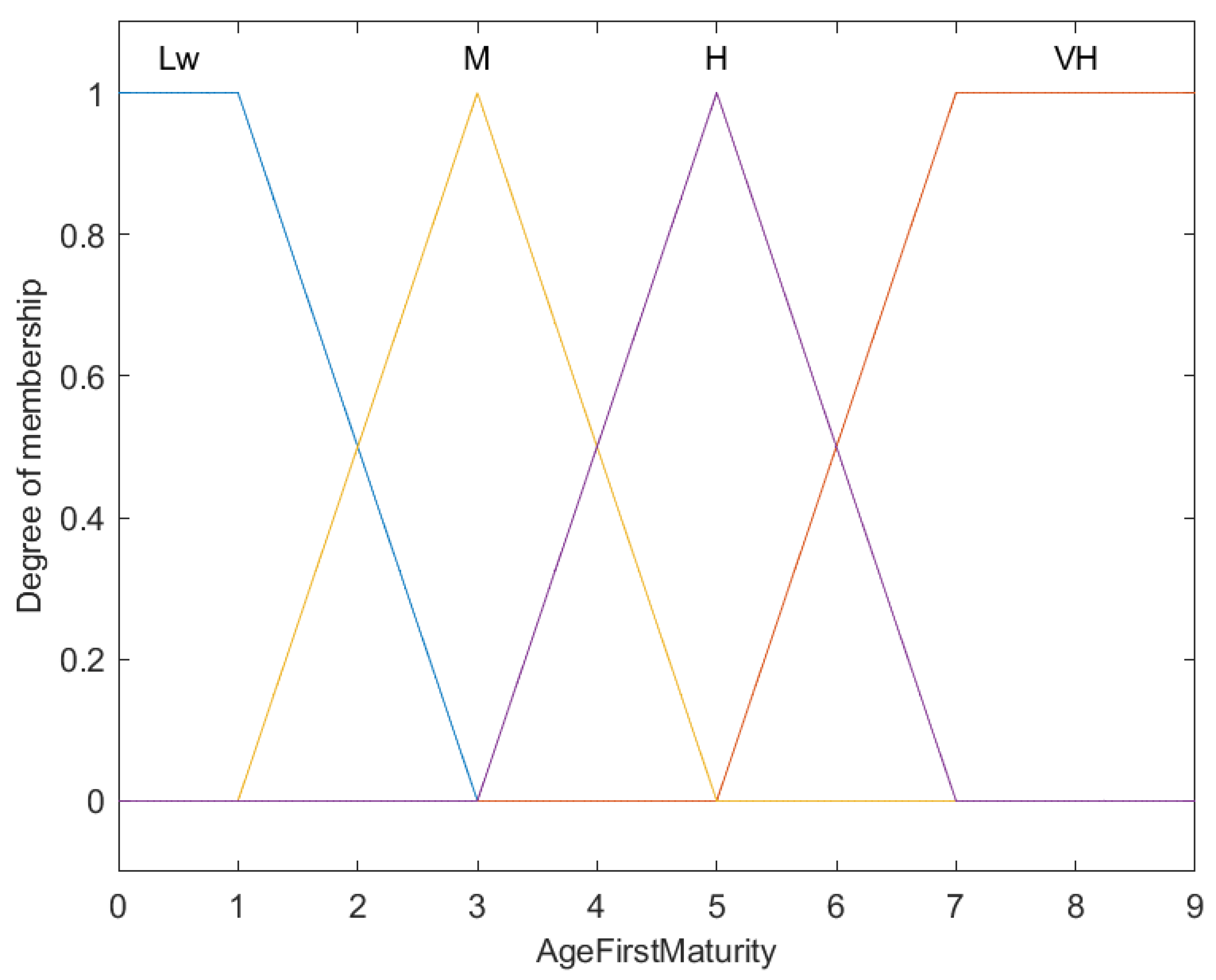
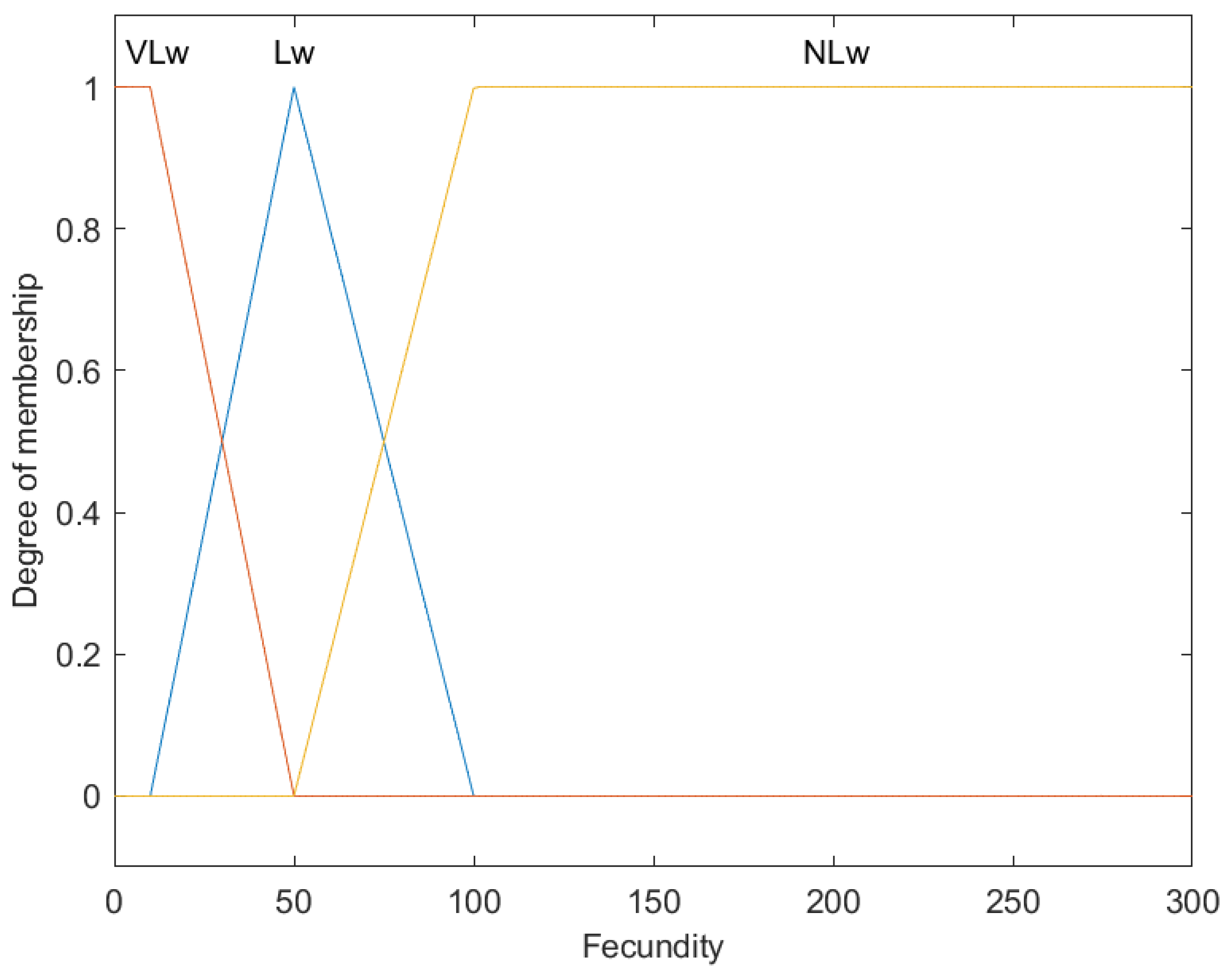
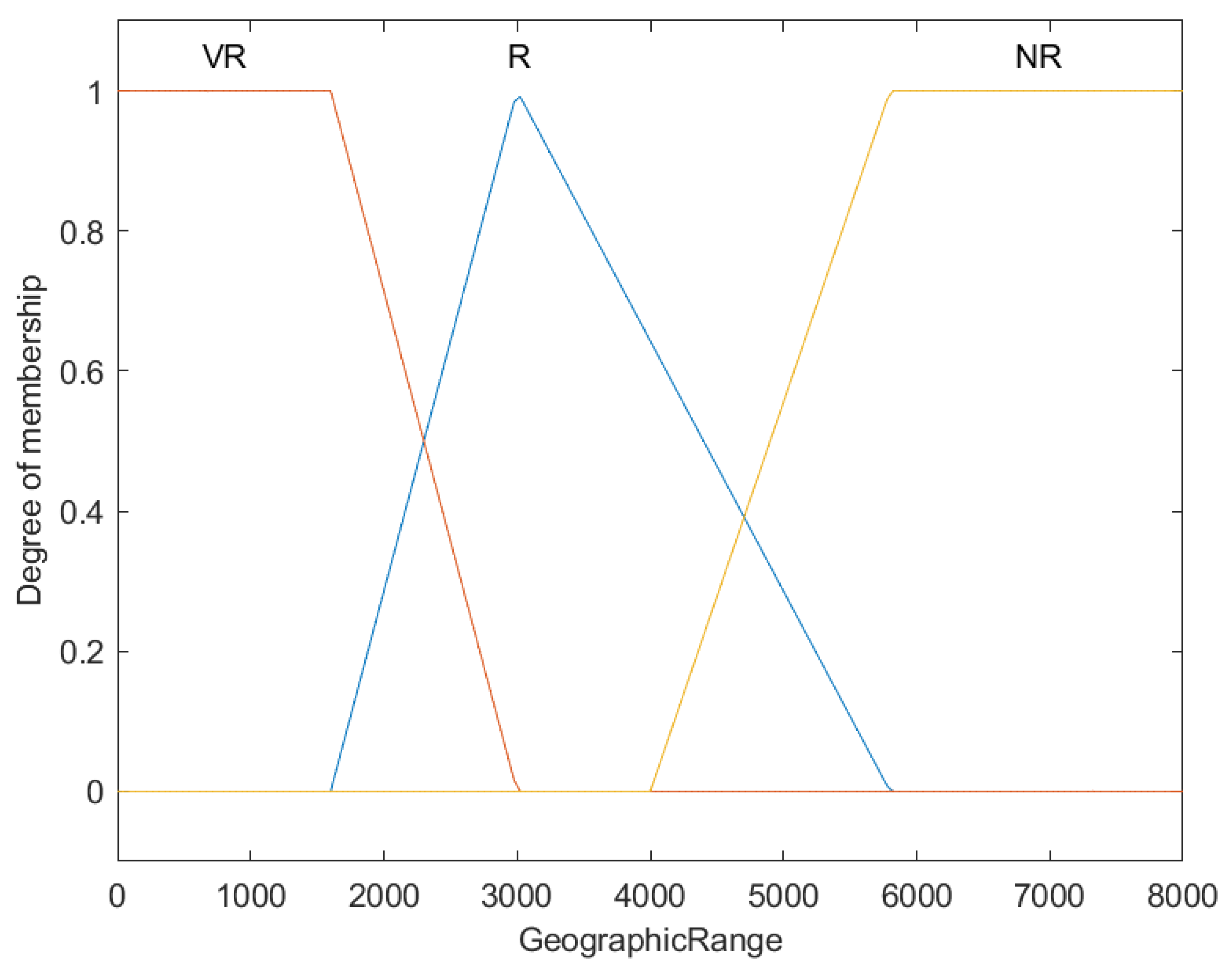
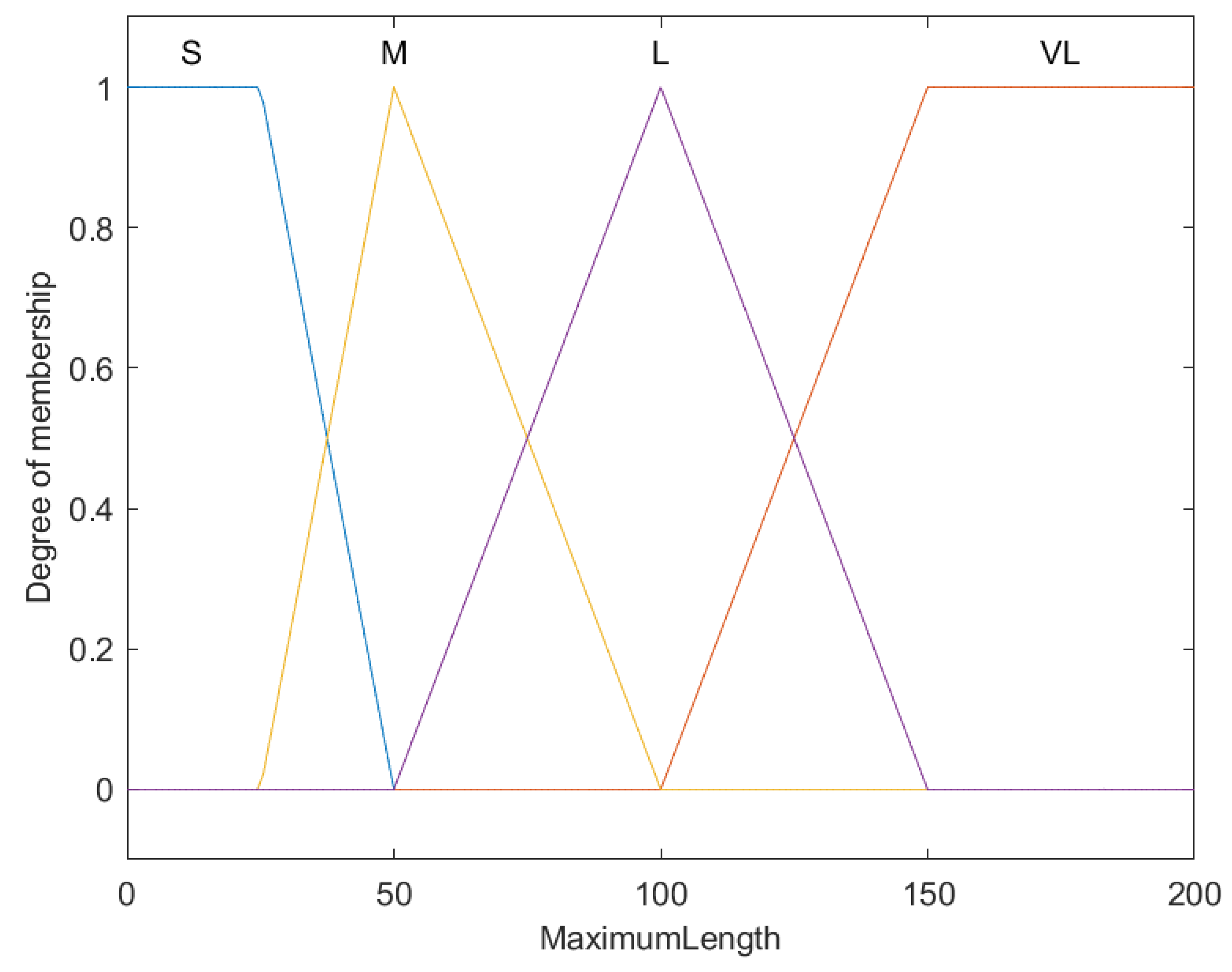
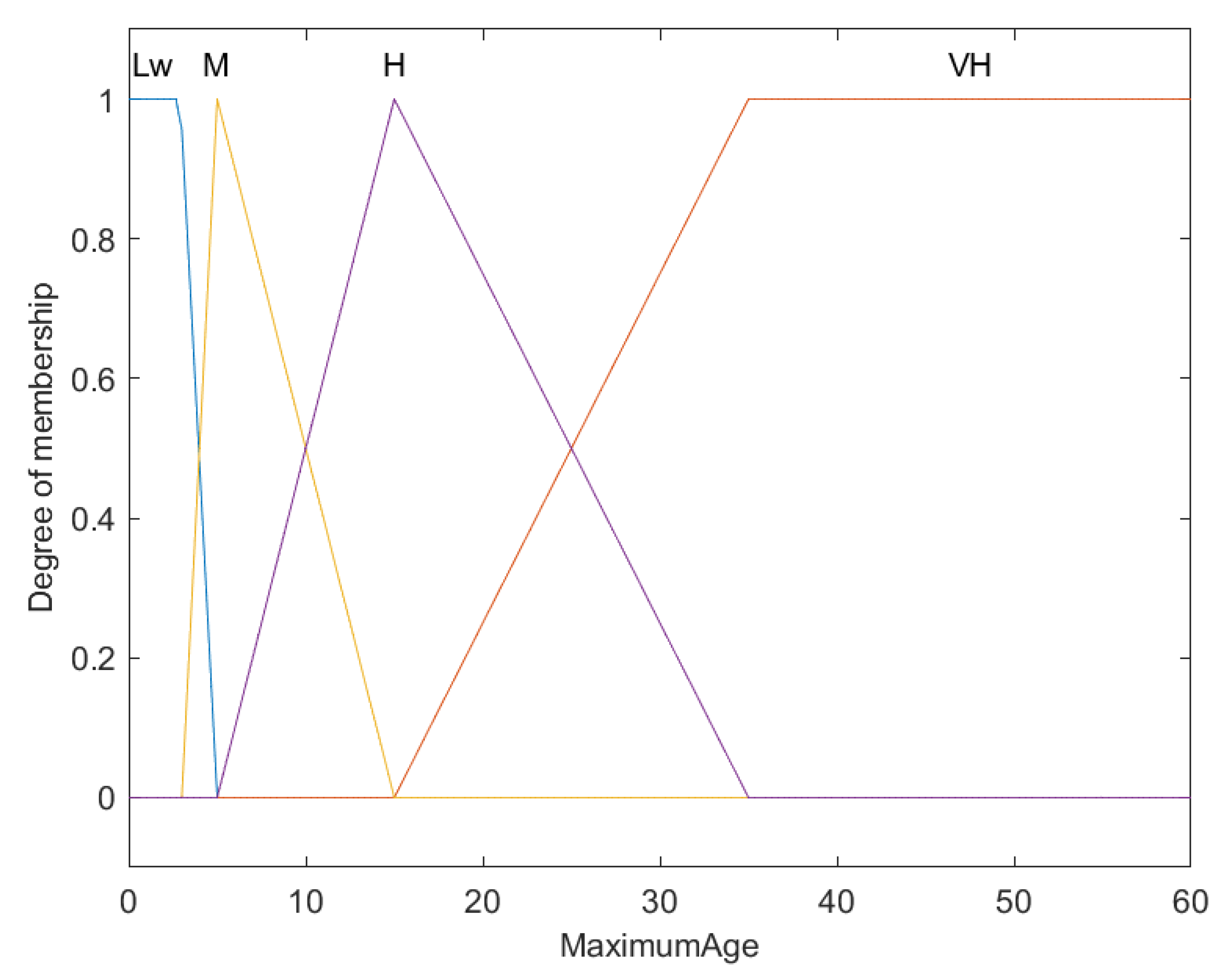
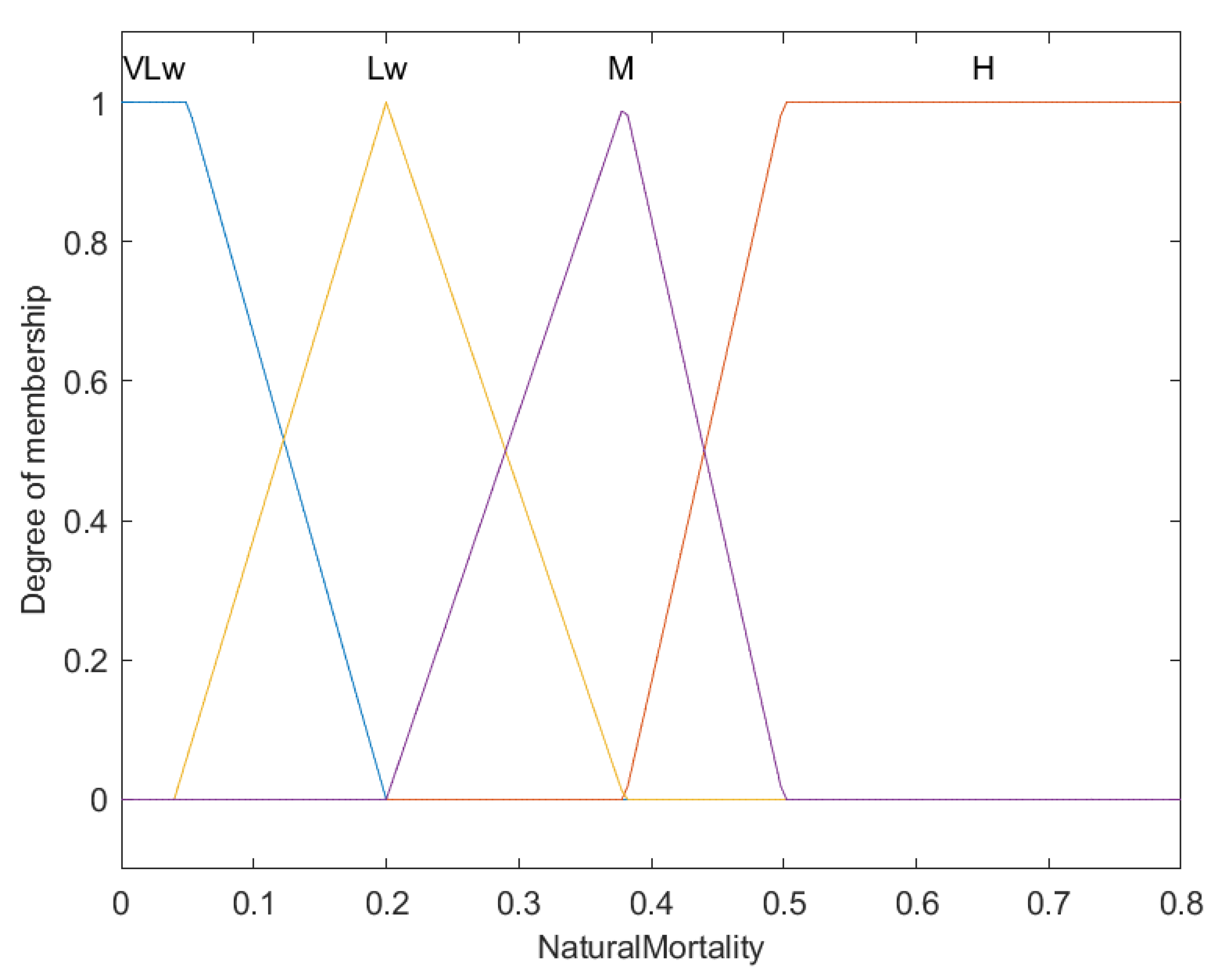
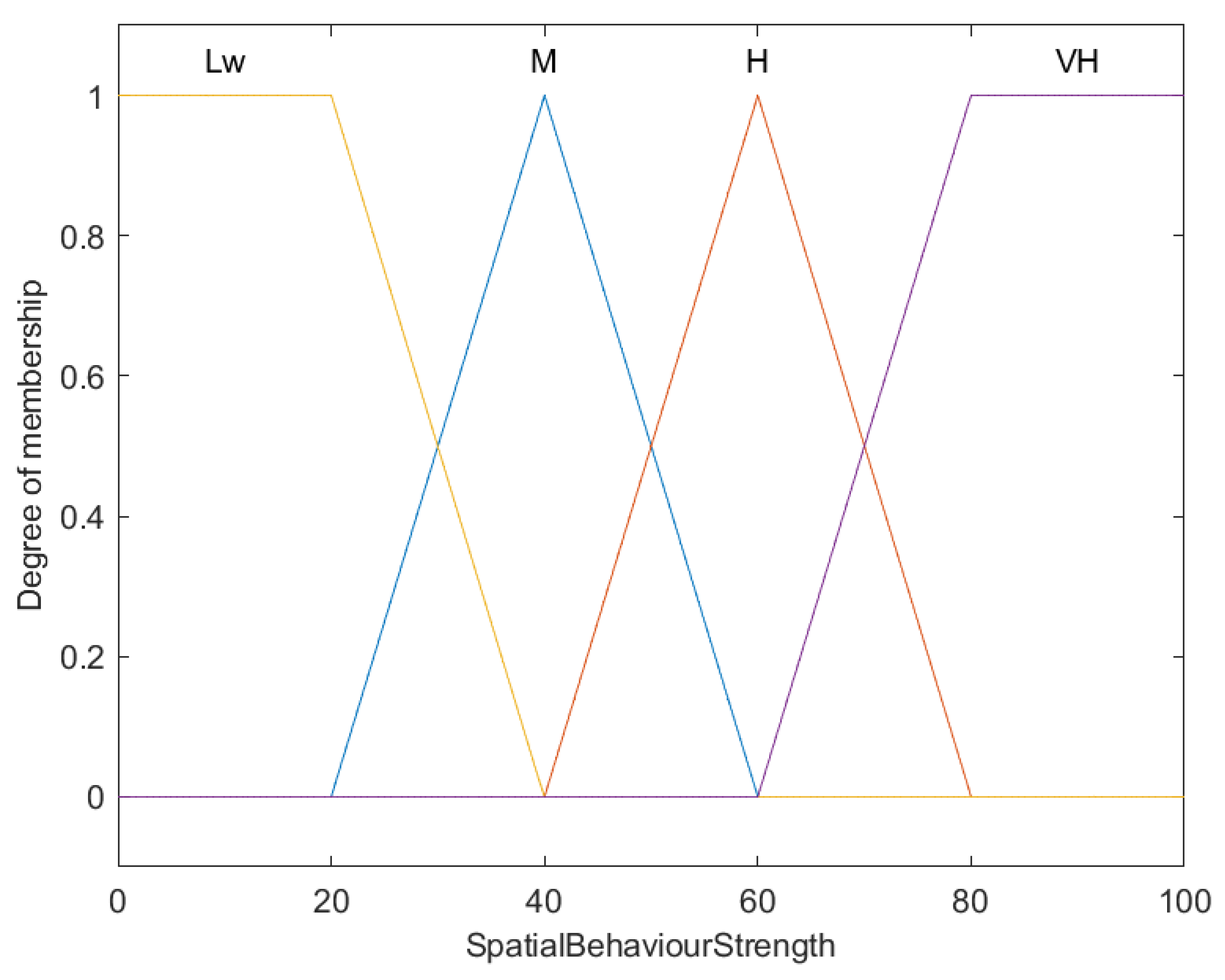
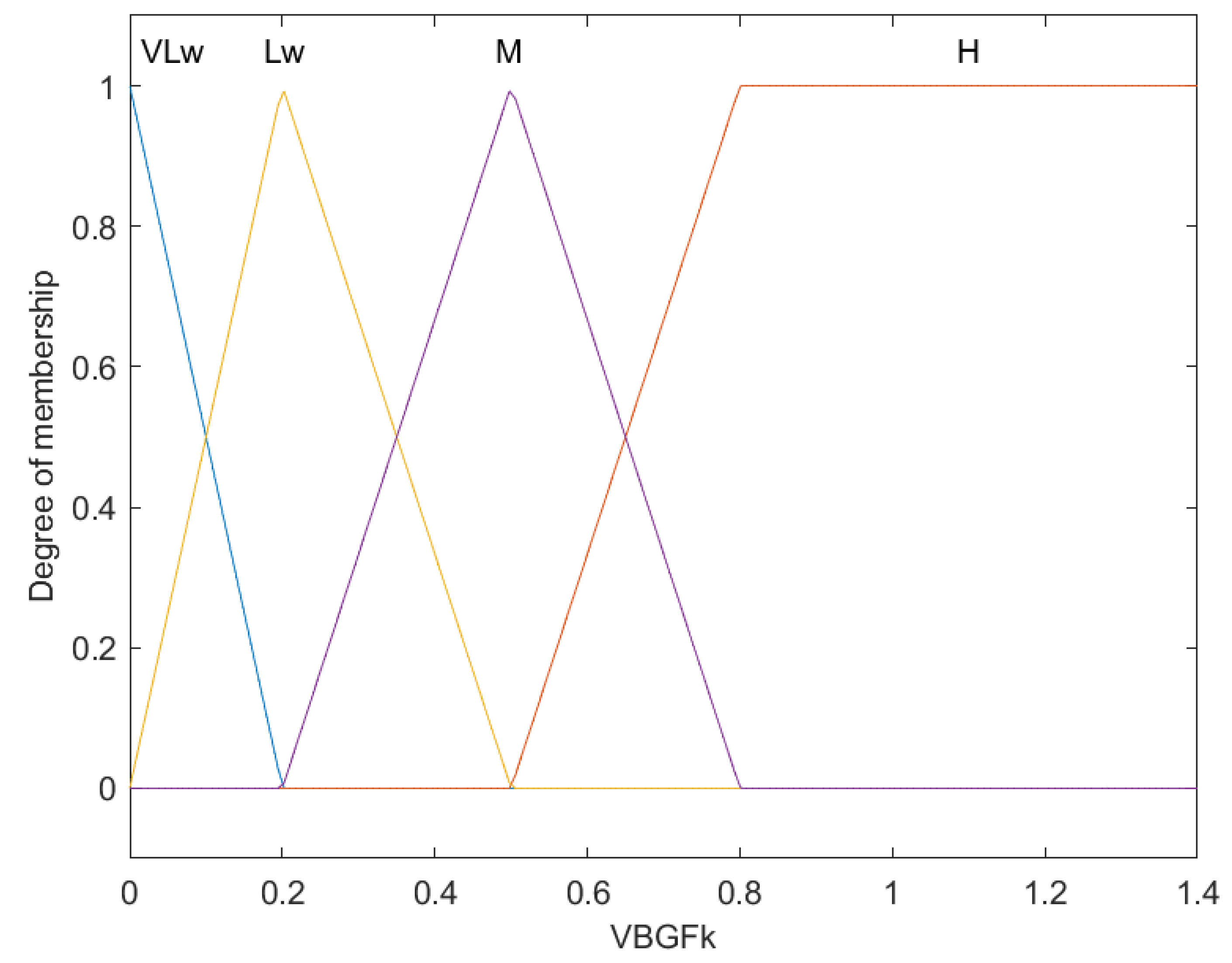
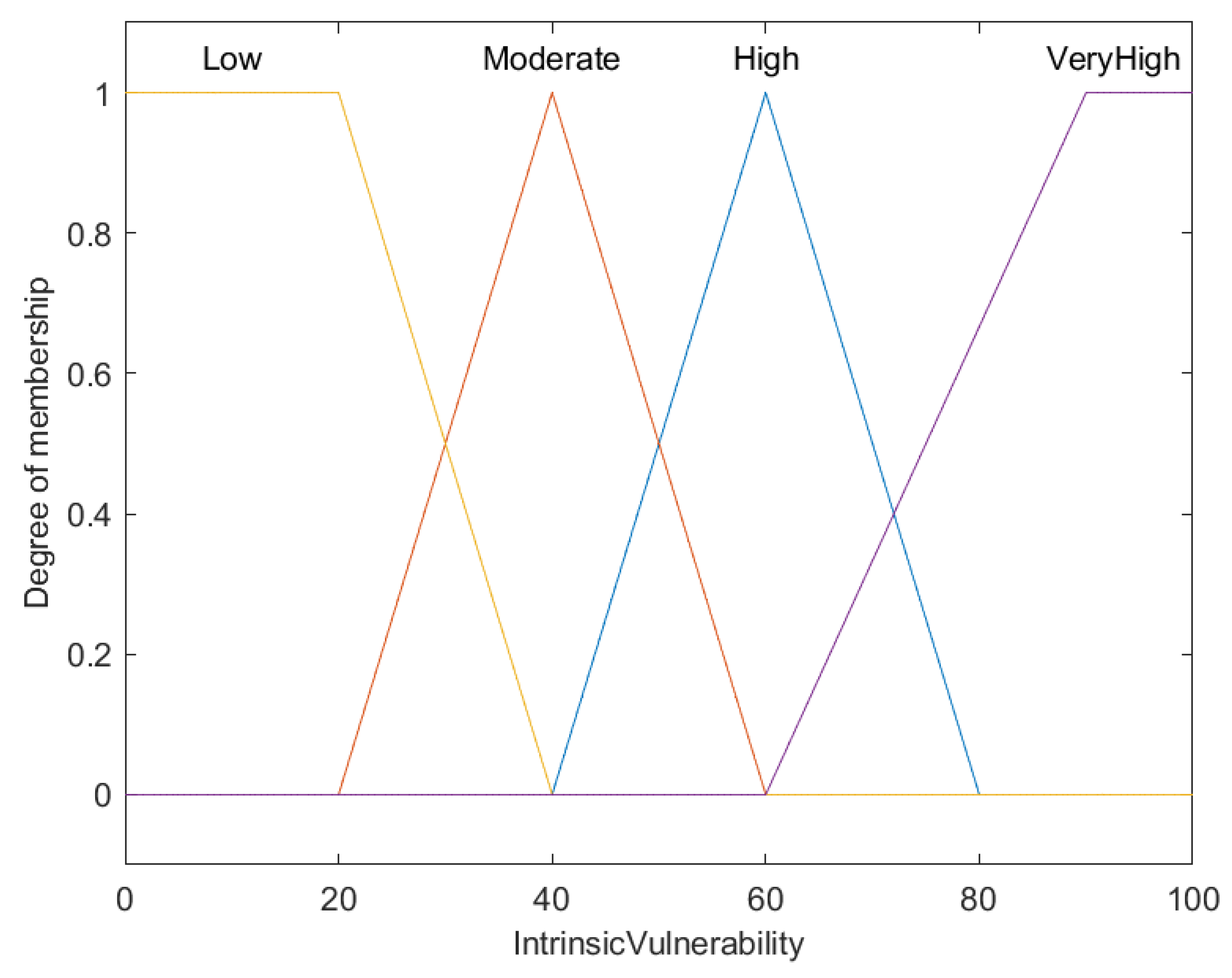

| Rule | Conditions | Consequences | ||
|---|---|---|---|---|
| 1 | IF | Maximum length is very large | THEN | Vulnerability is very high |
| 2 | IF | Maximum length is large | THEN | Vulnerability is high |
| 3 | IF | Maximum length is medium | THEN | Vulnerability is moderate |
| 4 | IF | Maximum length is small | THEN | Vulnerability is low |
| 5 | IF | Age at first maturity is very high | THEN | Vulnerability is very high |
| 6 | IF | Age at first maturity is high | THEN | Vulnerability is high |
| 7 | IF | Age at first maturity is medium | THEN | Vulnerability is moderate |
| 8 | IF | Age at first maturity is low | THEN | Vulnerability is low |
| 9 | IF | Maximum age is very high | THEN | Vulnerability is very high |
| 10 | IF | Maximum age is high | THEN | Vulnerability is high |
| 11 | IF | Maximum age is medium | THEN | Vulnerability is moderate |
| 12 | IF | Maximum age is low | THEN | Vulnerability is low |
| IF | VBGF K is very low | OR | ||
| 13 | IF | Natural mortality is very low | THEN | Vulnerability is very high |
| IF | VBGF K is low | OR | ||
| 14 | IF | Natural mortality is low | THEN | Vulnerability is high |
| IF | VBGF K is medium | OR | ||
| 15 | IF | Natural mortality is medium | THEN | Vulnerability is medium |
| IF | VBGF K is high | OR | ||
| 16 | IF | Natural mortality is high | THEN | Vulnerability is low |
| 17 | IF | Geographic range is restricted | THEN | Vulnerability is high |
| 18 | IF | Geographic range is very restricted | THEN | Vulnerability is very high |
| 19 | IF | Fecundity is low | THEN | Vulnerability is high |
| 20 | IF | Fecundity is very low | THEN | Vulnerability is very high |
| 21 | IF | Spatial behaviour strength is low | THEN | Vulnerability is low |
| 22 | IF | Spatial behaviour strength is moderate | THEN | Vulnerability is moderate |
| 23 | IF | Spatial behaviour strength is high | THEN | Vulnerability is high |
| 24 | IF | Spatial behaviour strength is very high | THEN | Vulnerability is very high |
| 25 | IF | Spatial behaviour is related to feeding aggregation | THEN | Vulnerability resulted from spatial behaviour decreases |
| 26 | IF | Spatial behaviour is related to spawning aggregation | THEN | Vulnerability resulted from spatial behaviour increases |
| Linguistic Variables | Linguistic Labels | Values |
|---|---|---|
| (Maximum length) | S (Small) | |
| (Age at first maturity) | Lw (Low) | |
| K (von Bertalanffy growth parameter) | H (High) | |
| M (Natural mortality rate) | H (High) | |
| (Maximum age) | Lw (Low) | |
| R (Geographic range) | NR (Not Restricted) | |
| F (Fecundity) | NLw (Not Low) |
Disclaimer/Publisher’s Note: The statements, opinions and data contained in all publications are solely those of the individual author(s) and contributor(s) and not of MDPI and/or the editor(s). MDPI and/or the editor(s) disclaim responsibility for any injury to people or property resulting from any ideas, methods, instructions or products referred to in the content. |
© 2025 by the authors. Licensee MDPI, Basel, Switzerland. This article is an open access article distributed under the terms and conditions of the Creative Commons Attribution (CC BY) license (https://creativecommons.org/licenses/by/4.0/).
Share and Cite
Gorrin-Ortega, Y.; Cardenas-Maciel, S.L.; Lopez-Renteria, J.A.; Cazarez-Castro, N.R. Parameters Determination via Fuzzy Inference Systems for the Logistic Populations Growth Model. Axioms 2025, 14, 36. https://doi.org/10.3390/axioms14010036
Gorrin-Ortega Y, Cardenas-Maciel SL, Lopez-Renteria JA, Cazarez-Castro NR. Parameters Determination via Fuzzy Inference Systems for the Logistic Populations Growth Model. Axioms. 2025; 14(1):36. https://doi.org/10.3390/axioms14010036
Chicago/Turabian StyleGorrin-Ortega, Yuney, Selene Lilette Cardenas-Maciel, Jorge Antonio Lopez-Renteria, and Nohe Ramon Cazarez-Castro. 2025. "Parameters Determination via Fuzzy Inference Systems for the Logistic Populations Growth Model" Axioms 14, no. 1: 36. https://doi.org/10.3390/axioms14010036
APA StyleGorrin-Ortega, Y., Cardenas-Maciel, S. L., Lopez-Renteria, J. A., & Cazarez-Castro, N. R. (2025). Parameters Determination via Fuzzy Inference Systems for the Logistic Populations Growth Model. Axioms, 14(1), 36. https://doi.org/10.3390/axioms14010036








